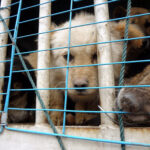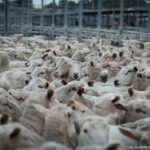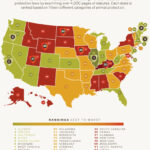The insidious reality of animal cruelty permeates our daily lives, manifesting itself in various forms ranging from neglect to outright violence. This scourge affects millions of innocent creatures globally. A staggering number of animals succumb to suffering and death each day, often without a voice to communicate their plight. Understanding the scope and depth of this phenomenon is essential, not just for the sake of the animals themselves but also for the ethical fabric of society.
Each day, countless animals are subjected to unspeakable horrors. The global toll varies significantly, impacted by factors such as geography, legislation, and public awareness. In regions where animal rights are largely ignored, the figure soars. It is estimated that millions of animals face neglect, violence, or exploitation every single day. Livestock, companion animals, and wildlife are among the most affected categories, but the specifics of each plight merit scrutiny.
**1. Livestock and Factory Farming**
Industrial agriculture is one of the primary contributors to animal fatalities. In the pursuit of profit, factory farming prioritizes efficiency over ethical considerations. Millions of chickens, pigs, cows, and other livestock animals are killed daily, often in inhumane conditions that undermine their basic welfare. Cramped quarters, poor sanitation, and lack of natural behaviors are commonplace in these facilities. It is reported that around 70 billion animals are killed each year worldwide for food. When broken down, this leads to an average of over 190 million animals dying every day for human consumption alone.
Beyond sheer numbers, consider the daily rituals of suffering that these animals endure. Chickens bred for meat often live in overcrowded pens where disease spreads rapidly. Many die from health complications before they even reach slaughter. Cows, subjected to an inhumane combination of confinement and mistreatment, are herded towards death, oftentimes after a lifetime void of proper care or compassion.
**2. Animal Testing**
Another significant contributor to animal deaths is the extensive use of animals in research and testing. This industry, which involves invasive procedures on rabbits, rats, primates, and other species, accounts for millions of animal lives lost annually. Estimates suggest that around 100 million animals are killed each year in laboratory settings, with countless others suffering from the effects of experimentation that do not lead to immediate death but leave lasting impacts on their well-being.
The methodologies employed in these experiments are often outdated and profoundly cruel. Animals are subjected to painful tests ranging from toxicology assessments to psychological examinations without any form of anesthesia. The ethical dilemma surrounding animal testing pushes the larger conversation towards the need for humane alternatives in scientific research.
**3. Companion Animals**
It is alarming to note that abuses extend to companion animals as well. Sadly, pet abandonment, abuse, and neglect are rampant issues, particularly in urban settings where the awareness of animal welfare may fall short. According to reports, around 3 million dogs and cats are put down in shelters each year—an average of about 8,000 a day—due to overpopulation and lack of resources. These numbers reflect a failure not just in individual actions, but a broader societal pattern where spaying, neutering, and adoption are not readily prioritized.
Dog fighting and similar cruel sports exacerbate the problem. Each day, countless animals are bred for combat or used as bait for fighting breeds. This penchant for violence forces animals into agonizing relationships with their own kind, resulting in injuries that often end in death or long-term psychological trauma.
**4. Wildlife and Habitat Destruction**
The plight of wildlife cannot be overlooked. Habitat destruction, poaching, and climate change pose threat to animal populations globally. The scale is immense, as thousands of species face extinction; it is estimated that an alarming 150 species of plants and animals go extinct daily—essentially irreversible losses to biodiversity. Driven by human greed and the relentless pursuit of industrial expansion, these actions lead to violent deaths not just directly meant for human consumption or profit but as collateral damage of human encroachment.
Consider the harrowing impact of trophy hunting, which claims the lives of many rare species for the sake of sport. Each day, iconic animals such as lions, elephants, and rhinos are hunted, often leading to a reduction in population that threatens their survival and disrupts ecosystems vital to our planet’s health. The numbers are both shocking and heart-wrenching: every 15 minutes, a lion is killed for sport, emphasizing the urgent need to confront the ethical implications of such practices.
**Towards Solutions**
In light of this grim reality, how do we move forward? Combating animal cruelty requires a multi-faceted approach. Education plays a crucial role in raising awareness of the issues at hand. By informing communities about the impacts of factory farming, laboratory testing, neglect, and poaching, strides can be taken towards fostering empathy and change.
Legal reforms are equally important. Advocacy for stronger animal protection laws is vital to reducing killings resulting from neglect and cruelty. More stringent regulations around factory farming and wildlife protection can help to ensure that fewer animals perish due to inhumane treatment.
Additionally, promoting adoption and spay/neuter programs can mitigate the number of surrendered pets on the streets and the high euthanasia rates in shelters. Support for organizations working at the grassroots level can help implement initiatives that may save countless lives and reduce daily tolls of suffering.
Ultimately, the conversation surrounding animal cruelty is nuanced and demanding. While numbers may provide a quantitative perspective, they fail to capture the profound emotional and ethical implications intertwined in each instance of suffering. One animal’s life is invaluable, underscoring the need for any discussion on cruelty to be rooted in compassion and the collective responsibility to protect those who cannot defend themselves.








